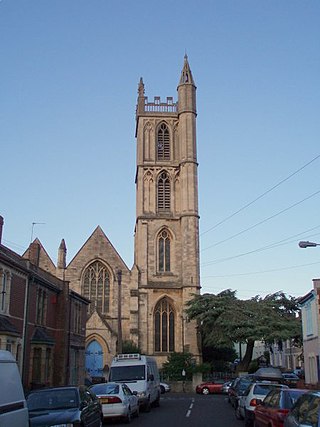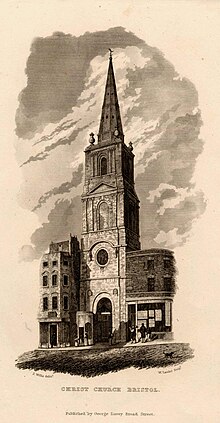
Bristol, the largest city in South West England, has an eclectic combination of architectural styles, ranging from the medieval to 20th century brutalism and beyond. During the mid-19th century, Bristol Byzantine, an architectural style unique to the city, was developed, and several examples have survived.

The Priory Church of St James, Bristol, is a Grade I listed building in Horsefair, Whitson Street.

Temple Church, also known as Holy Cross Church, is a ruined church in Redcliffe, Bristol, England. It is on the site of a previous, round church of the Knights Templar, which they built on land granted to them in the second quarter of the 12th century by Robert of Gloucester. In 1313 the Knights Hospitaller acquired the church, following the suppression of the Templars, only to lose it in 1540 at the time of the Dissolution of the Monasteries. By the early 14th century, the church served as the parish church for the area known as Temple Fee. From around the same time, the rebuilding of the church on a rectangular plan started. This was completed by 1460, with the construction of a leaning west tower.
William Paty was a British surveyor, architect and mason working mainly in Bristol.
Thomas Paty was a British surveyor, architect and mason working mainly in Bristol. He worked with his sons John Paty and William Paty.

Redland Parish Church is a Georgian church, built in 1742, in the Redland suburb of Bristol, England. It is a Grade I listed building.

St John on the Wall in Bristol is a historic church in the care of heritage charity The Churches Conservation Trust. The upper church and its medieval vaulted crypt is located at the lower end of Broad Street and is built into the old city's medieval walls.

Christ Church is a Church of England parish church in Clifton, Bristol, England. It has been designated as a Grade II* listed building.

St Mary on the Quay is a Roman Catholic Parish church in Bristol, England. It is situated on Colston Avenue, next to Colston Tower in the centre of the city. It is the oldest Roman Catholic church in Bristol; the first one built after the Reformation. it was formerly administered by the Society of Jesus and is currently served by the Divine Word Missionaries. It is a Grade II* listed building.

The Mount Without was a church now a creative space on St Michael's Hill in Bristol, England, near the University. It has been designated as a grade II* listed building, and was described as being in poor condition and on the Buildings at Risk Register.

St Werburgh's Church, Bristol, is a former church, now a climbing centre in the St Werburghs area of central north-east Bristol, England. It has been designated on the National Heritage List for England as a Grade II* listed building.

St. Augustine's Church was a Church of England church located on Whitchurch Lane in Whitchurch, Bristol.

Broad Street, along with High Street, Wine Street and Corn Street, is one of the four original streets that have made up the city of Bristol since Saxon times, when it was the burgh of Brycgstow.

The Church of St. John Baptist, Cirencester is a parish church in the Church of England in Cirencester, Gloucestershire, England. It is a Grade I listed building.
James Paty the Elder was an English mason, builder and architect. He was the first in a succession of members of the Paty family prominent in the building of 18th century Bristol. He is thought to have been the architect of Bristol's Old Library on King Street.
James Paty the Younger (1718–1779) was an English mason, builder and architect. He was a member of the Paty family which was prominent in the building of 18th century Bristol. He was the partner of his brother Thomas Paty in some of his building developments. He is also thought to have been the site architect during the rebuilding of Stoke Park House at Stoke Gifford.

St Cuthbert's Church is a Roman Catholic parish church in Durham, England. It was opened on 31 May 1827 to replace two previous chapels, one run by the secular clergy and the other by the Jesuits. It is also the home of the Durham University Catholic Chaplaincy and Catholic Society. From 2012 to 2016 the parish was entrusted, along with the chaplaincy, to the Dominican Order, and its congregation has since maintained the Dominicans' influence. The church is a protected building, being part of the Elvet Green Conservation Area. It is named for St Cuthbert of Lindisfarne, the 7th century bishop, healer and patron of Northern England.

The Anglican Parish Church of St Nicholas and the Blessed Virgin Mary at Stowey within the English county of Somerset dates from the 13th century. It is a Grade II listed building.

















